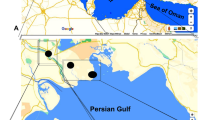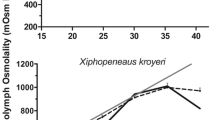Abstract
The effect of salinity was studied in natural populations of the black-chinned tilapia (Sarotherodon melanotheron) from West Africa. This euryhaline species colonizes nearly all coastal environments from bays to lagoons characterized by salinities ranging from fresh water to hypersaline water over 100 ‰. Individuals were sampled during the dry season at several locations characterized by different levels of salinity (3–102 ‰). Their osmotic status and their gills were analyzed. The branchial mitochondria-rich cells (MRC), localized at the basis of the filaments and along the lamellae in fish taken from the saline stations, showed a wide plasticity with significant differences in their number and size. The most striking results were a significant larger area (≈3x) and a higher number (≈55x) of MRC at high salinity (102 ‰) compared to low salinity (3 ‰). The major ion transporters and channels were localized by immunocytochemistry and different expression patterns have been recorded between stations. Despite an increased Na+/K+-ATPase (NKA) α-subunit expression and NKA activity, pointing to an increased monovalent ion excretion, a severe osmotic imbalance was recorded in animals living in hypersaline environments.





Similar content being viewed by others
References
Albaret JJ, Simier M, Darboe FS, Ecoutin JM, Raffray J, de Morais LT (2004) Fish diversity and distribution in the Gambia estuary, West Africa, in relation to environmental variables. Aquat Living Resour 17:35–46
Ando M, Mukuda T, Kozaka T (2003) Water metabolism in the eel acclimated to sea water: from mouth to intestine. Comp Biochem Physiol B Biochem Mol Biol 136(4):621–633
Bodinier C, Boulo V, Lorin-Nebel C, Charmantier G (2009) Influence of salinity on the localization and expression of the CFTR chloride channel in the ionocytes of Dicentrarchus labrax during ontogeny. J Anat 214:318–329
Deane EE, Woo NY (2004) Differential gene expression associated with euryhalinity in sea bream (Sparus sarba). Am J Physiol Regul Integr Comp Physiol 287:R1054–R1063
Diouf PS (1996) Les peuplements de poissons des milieux estuariens d’Afrique de l’Ouest : l’exemple de l’estuaire hyperhalin du Sine-Saloum. Thèses et Documents microfiches No. 156, ORSTOM, Paris
Diouf K, Panfili J, Labonne M, Aliaume C, Tomas J, Do Chi T (2006) Effects of salinity on strontium: calcium ratios in the otoloths of the West African black-chinned tilapia Sarotherodon melanotheron in a hypersaline estuary. Environ Biol Fish 77:9–20
Evans D (ed) (2009) Osmotic and ionic regulation: cells and animals. CRC Press Taylor & Francis Group, Boca Raton
Evans D, Clairborne JB (2009) Osmotic and ionic regulation in fishes. In: Evans DH (ed) Osmotic and ionic regulation: cells and animals, CRC press, Boca Raton, pp 295–366
Evans DH, Piermarini PM, Choe KP (2005) The multifunctional fish gill: dominant site of gas exchange, osmoregulation, acid-base regulation, and excretion of nitrogenous waste. Physiol Rev 85(1):97–177
Falk TM, Teugels GG, Abban EK, Villwock W, Renwrantz L (2003) Phylogeographic patterns in populations of the black-chinned tilapia complex (Teleostei, Cichlidae) from coastal areas in West Africa: support for the refuge zone theory. Mol Phylogenet Evol 27(1):81–92
Flik G, Wendelaar Bonga S, Fenwick J (1983) Ca2+-dependent phosphatase and ATPase activities in eel gill plasma membranes. I. Identification of Ca2+-activated ATPase activities with non-specific phosphatase activities. Comp Biochem Physiol B 76:745–754
Gonzalez R (2011) The physiology of hyper-salinity tolerance in teleost fish: a review. J Comp Physiol B:1–9. doi:10.1007/s00360-011-0624-9
Hiroi J, Yasumasu S, McCormick SD, Hwang P-P, Kaneko T (2008) Evidence for an apical Na–Cl cotransporter involved in ion uptake in a teleost fish. J Exp Biol 211(16):2584–2599. doi:10.1242/jeb.018663
Hwang P, Lee T (2011) New insights into fish ion regulation and mitochondrion-rich cells. Comp Biochem Physiol A 148:479–497
Jensen K, Madsen SS, Kristiansen K (1998) Osmoregulation and salinity effects on the expression and activity of Na+, K+-ATPase in the gills of European sea bass, Dicentrarchus labrax (L.). J Exp Zool 282:290–300
Lemarié G, Baroiller J-F, Clota F, Lazard J, Dosdat A (2004) A simple test to estimate the salinity resistance of fish with specific application to O. niloticus and S. melanotheron. Aquaculture 240:575–587
Lundgreen K, Kiilerich P, Tipsmark CK, Madsen SS, Jensen FB (2008) Physiological response in the European flounder (Platichthys flesus) to variable salinity and oxygen conditions. J Comp Physiol B 178:909–915
Marshall WS, Grosell M (2006) Ion transport, osmoregulation and acid–base balance. The physiology of fishes, 3rd edn. CRC Press, Boca Raton, pp 177–230
Ouattara NG, Bodinier C, Nègre-Sadargues G, D’Cotta H, Messad S, Charmantier G, Panfili J, Baroiller J-F (2009) Changes in gill ionocyte morphology and function following transfer from fresh to hypersaline waters in the tilapia Sarotherodon melanotheron. Aquaculture 290(1–2):155–164
Panfili J, Durand J, Mbow A, Guinand B, Diop K, Kantoussan J, Thior D, Thiaw O, Albaret J-J, Laë R (2004a) Influence of salinity on life history traits of the bonga shad Ethmalosa fimbrata (Pisces, Clupeidae): comparison between the Gambia and Saloum estuaries. Mar Ecol Progr Ser 270:241–257
Panfili J, Mbow A, Durand J-D, Diop K, Diouf K, Thior D, Ndiaye P, Laë R (2004b) Influence of salinity on the life-history traits of the West African black-chinned tilapia (Sarotherodon melanotheron): comparison between the Gambia and Saloum estuaries. Aquat Living Ressou 17:65–74
Perry SF (1998) Relationships between branchial chloride cells and gas transfer in freshwater fish. Comp Biochem Physiol 119A:9–16
Pouyaud L, Desmarais E, Chenuil A, Agnese TF, Bonhomme F (1999) Kin cohesiveness and possible inbreeding in the mouthbrooding tilapia Sarotherodon melanotheron (Pisces Cichlidae). Molecular Ecology 8(5):803–812. doi:10.1046/j.1365-294X.1999.00632.x
Simier M, Blanc L, Aliaume C, Diouf PS, Albaret JJ (2004) Spatial and temporal structure of fish assemblages in an “inverse estuary”, the Sine Saloum system (Senegal). Estuar Coast Shelf Sci 59(1):69–86
Tine M, de Lorgeril J, Panfili J, Diop K, Bonhomme F, Durand JD (2007) Growth hormone and prolactin-1 gene transcription in natural populations of the black-chinned tilapia Sarotherodon melanotheron acclimatised to different salinities. Comp Biochem Physiol B Biochem Mol Biol 147(3):541–549. doi:10.1016/j.cbpb.2007.03.010
Tine M, De Lorgeril J, D’Cotta H, Pepey E, Bonhomme F, Baroiller J-F, Durand JD (2008) Transcriptional responses of the black-chinned tilapia Sarotherodon melanotheron to salinity extremes. Mar Genomics 1:37–46
Tine M, Bonhomme F, McKenzie DJ, Durand J-D (2010) Differential expression of the heat shock protein Hsp70 in natural populations of the tilapia, Sarotherodon melanotheron, acclimatised to a range of environmental salinities. BMC Ecol 10:11–18
Tine M, McKenzie DJ, Bonhomme F, Durand JD (2011) Salinity-related variation in gene expression in wild populations of the black-chinned tilapia from various West African coastal marine, estuarine and freshwater habitats. Estuar Coast Shelf Sci 91:102–109
Trape S, Durand J-D, Guilhaumon F, Vigliola L, Panfili J (2009) Recruitment patterns of young-of-the-year mugilid fishes in a West African estuary impacted by climate change. Estuar Coast Shelf Sci 85:357–367
Uchida K, Kaneko T, Miyazaki H, Hasegawa S, Hirano T (2000) Excellent salinity tolerance of Mozambique tilapia (Oreochromis mossambicus): elevated chloride cell activity in the branchial and opercular epithelia of the fish adapted to concentrated seawater. Zool Sci 17(2):149–160
Acknowledgments
This work was supported by an INSU-EC2CO grant (ECLIPSE). We thank Dr. Julien Issartel for constructive advice and discussions. We also like to thank Mrs. Khady Diop for her technical help.
Author information
Authors and Affiliations
Corresponding author
Additional information
Communicated by I.D. Hume.
Rights and permissions
About this article
Cite this article
Lorin-Nebel, C., Avarre, JC., Faivre, N. et al. Osmoregulatory strategies in natural populations of the black-chinned tilapia Sarotherodon melanotheron exposed to extreme salinities in West African estuaries. J Comp Physiol B 182, 771–780 (2012). https://doi.org/10.1007/s00360-012-0657-8
Received:
Revised:
Accepted:
Published:
Issue Date:
DOI: https://doi.org/10.1007/s00360-012-0657-8




